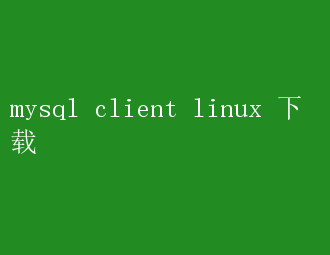Linux下MySQL客户端下载指南
资源类型:00-5.net 2025-06-18 09:29
mysql client linux 下载简介:

MySQL Client for Linux: A Comprehensive Guide to Download and Utilization In the realm of relational database management systems(RDBMS), MySQL stands out as one of the most robust, versatile, and widely used platforms. Its popularity stems from a combination of factors, including its open-source nature, extensive feature set, robust performance, and seamless integration with various programming languages and applications. For Linux users, having a reliable MySQL client installed on their system is crucial for efficient database management and administration. This guide delves into the process of downloading and utilizing the MySQL client on Linux, emphasizing the importance, steps involved, and best practices to ensure a smooth experience. The Importance of MySQL Client for Linux Before diving into the specifics of downloading and using the MySQL client, its essential to understand why its indispensable for Linux users. MySQL is often the backbone of numerous web applications, content management systems(CMS), and enterprise solutions. Whether youre a developer working on a new project, a DBA managing a production database, or a system administrator ensuring database integrity and performance, having direct access to the MySQL server via a client is paramount. 1.Administrative Tasks: The MySQL client allows for the execution of SQL commands directly on the server, facilitating tasks such as user management, schema design, data import/export, and performance tuning. 2.Development Workflow: Developers often need to query databases, test SQL scripts, and interact with databases in real-time. The client provides a direct interface for these activities. 3.Data Analysis: Analysts and researchers can use the client to run complex queries, generate reports, and perform data analysis without relying on third-party tools. 4.Troubleshooting: When issues arise, having direct access to the MySQL server via the command line can expedite diagnosis and resolution. Given these benefits, its clear that having the MySQL client installed on your Linux machine is not just convenient but also necessary for effective database management. Downloading MySQL Client for Linux The process of downloading and installing the MySQL client on Linux can vary slightly depending on your Linux distribution. Below are detailed instructions for some of the most popular distributions: Ubuntu/Debian, CentOS/RHEL, and Fedora. Ubuntu/Debian For Ubuntu and Debian-based systems, you can leverage the official MySQL APT repository to ensure you get the latest stable version. 1.Update Package Lists: bash sudo apt update 2.Install MySQL Client: bash sudo apt install mysql-client This command will install the necessary packages for the MySQL command-line client(`mysql`). CentOS/RHEL For CentOS and Red Hat Enterprise Linux(RHEL), you can use the official MySQL YUM repository. 1.Download and Install the MySQL YUM Repository: bash sudo yum localinstall https://dev.mysql.com/get/mysql80-community-release-el7-5.noarch.rpm Note: The URL may change with new versions. Always refer to the MySQL official documentation for the latest link. 2.Enable the MySQL Community (GPL) Repository: By default, this repository is disabled. Enable it by running: bash sudo yum-config-manager --enable mysql80-community 3.Install MySQL Client: bash sudo yum install mysql Fedora Fedora users can also benefit from the MySQL DNF repository. 1.Download and Install the MySQL DNF Repository: bash sudo dnf install https:/